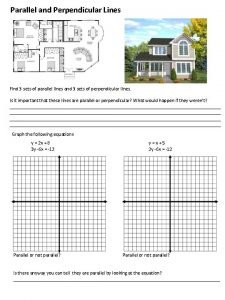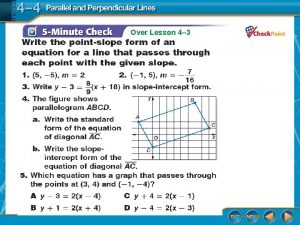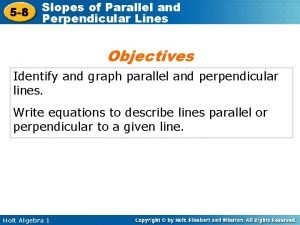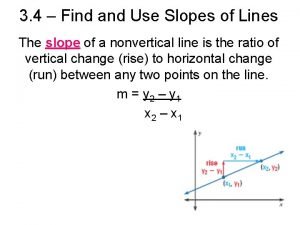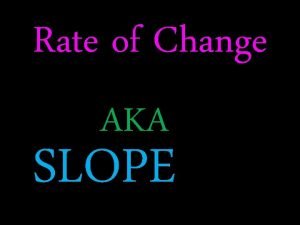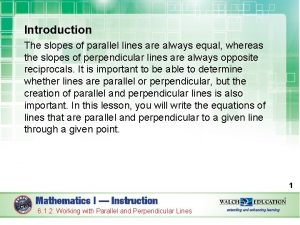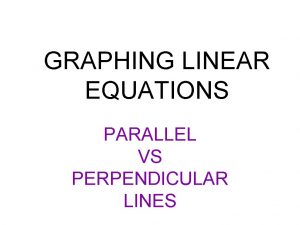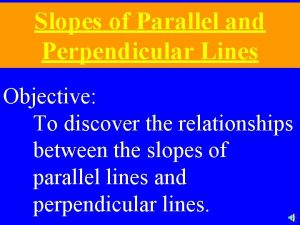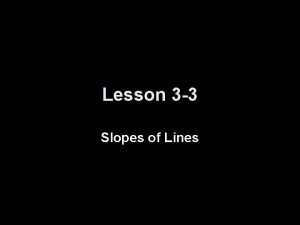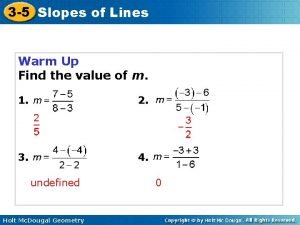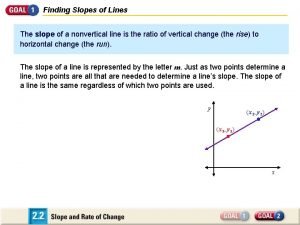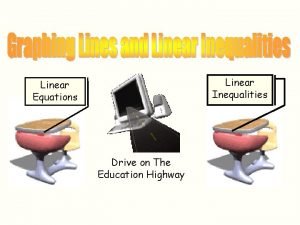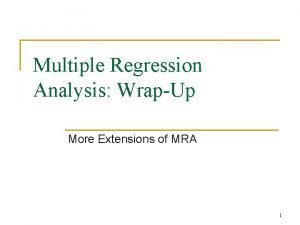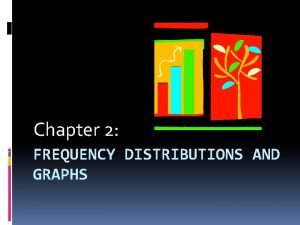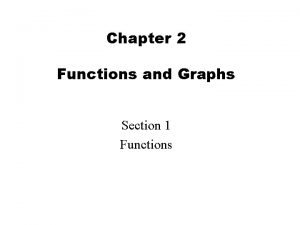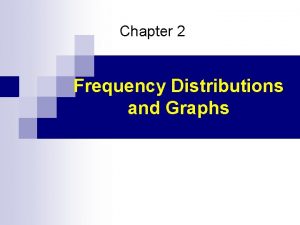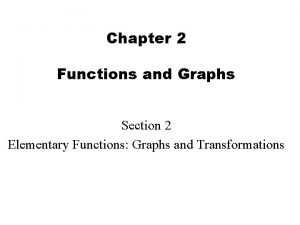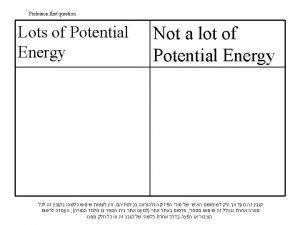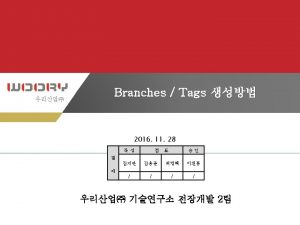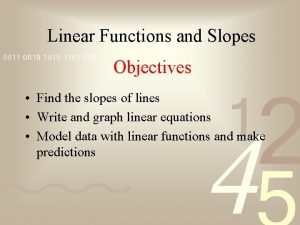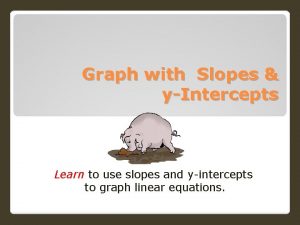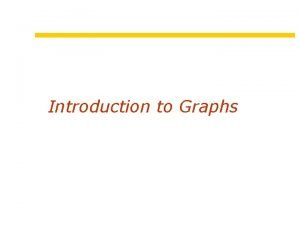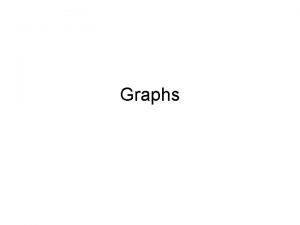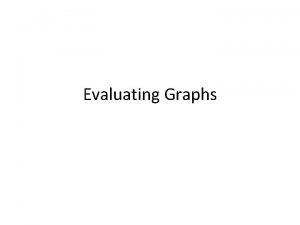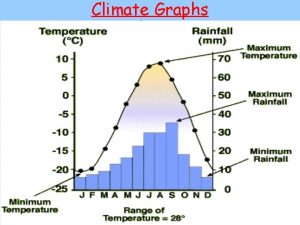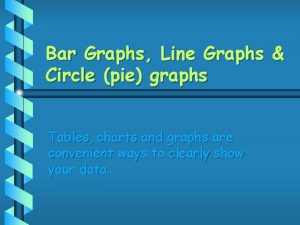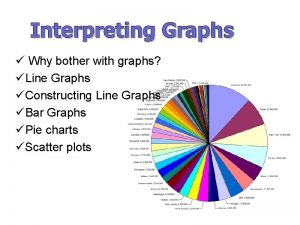Chapter 4 GRAPHS AND SLOPES When you have
































































- Slides: 64

Chapter 4 GRAPHS AND SLOPES

When you have completed your study of this chapter, you will be able to 1 Interpret graphs that display data. 2 Interpret the graphs used in economic models. 3 Define and calculate slope. 4 Graph relationships among more than two variables.

MAKING AND USING GRAPHS <Basic Idea – A graph enables us to visualize the relationship between two variables. – To make a graph, set two lines perpendicular (dikine) to each other: • The horizontal line is called the x-axis. • The vertical line is called the y-axis. • The common zero point is called the origin.

Figure 1 shows how to make a graph. 1. The horizontal axis (x-axis) measures temperature. 2. The vertical axis (y-axis) measures ice cream consumption.

MAKING AND USING GRAPHS 3. Point A shows that when the temperature is 40 degrees, ice cream consumption is only 5 gallons a day. 4. Point B shows that when the temperature is 80 degrees, ice cream consumption jumps to 20 gallons a day.

Interpreting Graphs Used in Economic Models – Positive relationship or direct relationship is a relationship between two variables that move in the same direction. • negative relationship A relationship in which two variables move in opposite directions. Linear relationship is a relationship that graphs as a straight line.

Figure 2 shows a positive (direct) relationship. At a speed of 40 MPH, you travel 200 miles in 5 hours— point A. At a speed of 60 MPH, you travel 300 miles in 5 hours— point B. As the speed increases, the distance traveled in 5 hours increases proportionately, or the higher the speed, the greater the distance traveled in five hours

Figure 3 shows a positive (direct) relationship. As the distance sprinted increases, recovery time increases. Koşu mesafesi arttıkça, iyileşme süresi artar. But sprint twice as far and it takes more than twice as long to recover—the curve gets steeper. Look at the arrow… Koşu mesafesi iki kat artınca, iyileşme süresi iki katından fazla artar. dik

Figure 4 shows a positive (direct) relationship. As study time increases, the number of problems worked increases. Çalışma süresi arttıkça, çalışılan problem sayısı artacaktır But study twice as long and the number of problems you work less than double —the curve gets less steep. Look at the arrow… Çalışma süresi iki katı arttınca, çalışılan problem sayısı iki katından az artar.

Figure 5 shows a negative (inverse) relationship. As the time playing tennis increases, the time playing squash decreases. Because one more hour of tennis means one hour less of squash, the relationship between these two variables is described by a straight line.

FIGURE 6 Relationship between Hours Worked and Income Y Y = 8 X There is a positive relationship between work hours and income, so the income curve is positively sloped. The slope(eğim)of the curve is $8: Each additional hour of work increases income by $8. Conclusion: If hours worked per week increase one unit, the income per week will increase 8 units. X

Computing the Slope • slope of a curve – The vertical difference between two points (the rise) divided by the horizontal difference (the run). In general, if the variable on the vertical axis is Y and the variable on the horizontal axis is X, we can express the slope as

MAKING AND USING GRAPHS Figure 7 shows a negative (inverse) relationship. As the journey length increases, the cost per mile of the trip falls. But there is a limit to how much the cost per mile can fall, so the curve becomes less steep as journey length increases.

APPENDIX: MAKING AND USING GRAPHS Figure 8 shows a negative (inverse) relationship. As leisure time increases, the number of problems worked decreases. But during the tenth hour of leisure (the first hour of work) the decrease in the number of problems worked is largest, so the curve becomes steeper as leisure time increases.

MAKING AND USING GRAPHS Figure 9 shows a maximum point. As the rainfall increases: 1. The curve slopes upward as the yield rises. 2. The curve is flat at point A, the maximum yield. 3. Then slopes downward as the yield falls.

MAKING AND USING GRAPHS Figure 10 shows a minimum point. As the speed increases: 1. The curve slopes downward as the cost per mile falls. 2. The curve is flat at point B, the minimum cost per mile. 3. The curve slopes upward as the cost per mile rises.

Figure 11 shows variables that are unrelated. The line or the curve is horizontal As the price of bananas increases, the student’s grade in economics remains at 75 percent. There is no relation between the grade and price of bananas. unrelated variables.

Figure 12 shows variables that are unrelated. As rainfall in California increases, the output of French vineyards(üzüm bağları)remains at 3 billion gallons. The line is vertical.

EX: 1. When ∆x is 4. (6 -2), 2. ∆y is 3. (6 -3). 3. Slope (∆y/∆x) is 3/4. Slope is positive

EX: 1. When ∆x is 4, 2. ∆y is – 3. 3. Slope (∆y/∆x) is – 3/4. Slope is negative

MAKING AND USING GRAPHS Figure 13 shows the slope of a curve at a point. Slope of the curve at A equals the slope of the red line tangent (teğet) to the curve at A. 1. When ∆x is 4, 2. ∆y is 3. 3. Slope (∆y/∆x) is 3/4.

MAKING AND USING GRAPHS • Relationships Among More Than Two Variables – To graph a relationship that involves more than two variables, we use the ceteris paribus assumption. – Ceteris Paribus – “other things remaining the same” – Figure 14 shows the relationships between ice cream consumed, the temperature, and the price of ice cream.

APPENDIX: AND USING As price increases. MAKING the consumption of ice cream on different GRAPHS temperatures decreases (because the slope is negative) Figure 14 shows the relationship between price and consumption, temperature remaining the same.

As temperature the AND consumption APPENDIX: increases MAKING USING of ice cream on different price level GRAPHS increases, because the slope is positive Figure 15 shows the relationship between temperature and consumption, price remaining the same.

MAKING AND USING GRAPHS Figure 16 shows the relationship between price and temperature, consumption remaining the same.

Movement Along a Curve versus Shifting the Curve ► FIGURE 17 Movement Along a Curve versus Shifting the Curve To draw a curve showing the relationship between hours worked and income, we fix the weekly allowance (haftalık harçlık) ($40) and the wage ($8 per hour). A change in the hours worked causes movement along the curve, for example, from point b to point c. A change in any other variable shifts the entire curve. For example, a $50 increase in the allowance (to $90) shifts the entire curve upward by $50.

Nonlinear Relationships Graphing Nonlinear Relationships ► FIGURE 18 Nonlinear Relationships (A) Study time There is a positive and nonlinear relationship between study time and the grade on an exam. As study time increases, the exam grade increases at a decreasing rate. For example, the second hour of study increased the grade by 4 points (from 6 points to 10 points), but the ninth hour of study increases the grade by only 1 point (from 24 points to 25 points).

Nonlinear Relationships Graphing Nonlinear Relationships ► FIGURE 19 Nonlinear Relationships (B) Production cost There is a positive and nonlinear relationship between the quantity of grain produced and total production cost. As the quantity increases, the total cost increases at an increasing rate. For example, to increase production from 1 ton to 2 tons, production cost increases by $5 (from $10 to $15) but to increase the production from 10 to 11 tons, total cost increases by $25 (from $100 to $125).

FIGURE 2 A Curve with (a) Positive Slope and (b) Negative Slope A positive slope indicates that increases in X are associated with increases in Y and that decreases in X are associated with decreases in Y. A negative slope indicates the opposite— when X increases, Y decreases; and when X decreases, Y increases.

Changing Slopes Along Curves

Time Series Graphs • A time series graph shows how a single measure or variable changes over time.

TABLE 1 Total Disposable Personal Income in the United States, 1975– 2012 (in billions of dollars) Year 1975 1976 1977 1978 1979 1980 1981 1982 1983 1984 1985 1986 1987 1988 1989 1990 1991 1992 1993 Total Disposable Personal Income 1, 187. 3 1, 302. 3 1, 435. 0 1, 607. 3 1, 790. 8 2, 002. 7 2, 237. 1 2, 412. 7 2, 599. 8 2, 891. 5 3, 079. 3 3, 258. 8 3, 435. 3 3, 726. 3 3, 991. 4 4, 254. 0 4, 444. 9 4, 736. 7 4, 921. 6 Year 1994 1995 1996 1997 1998 1999 2000 2001 2002 2003 2004 2005 2006 2007 2008 2009 2010 2011 2012 Total Disposable Personal Income 5, 184. 3 5, 457. 0 5, 759. 6 6, 074. 6 6, 498. 9 6, 803. 3 7, 327. 2 7, 648. 5 8, 009. 7 8, 377. 8 8, 889. 4 9, 277. 3 9, 915. 7 10, 423. 6 11, 024. 5 10, 772. 4 11, 127. 1 11, 549. 3 11, 930. 6 Total Disposable Personal Income in the United States: 1975– 2012 (in billions of dollars)

Plotting Income and Consumption Data for Households TABLE 2 Consumption Expenditures and Income, 2008 Bottom fifth 2 nd fifth 3 rd fifth 4 th fifth Top fifth Average Income Before Taxes Average Consumption Expenditures $ 10, 263 27, 442 47, 196 74, 090 158, 652 $ 22, 304 31, 751 42, 659 58, 632 97, 003 FIGURE 11 Household Consumption and Income A graph is a simple two-dimensional geometric representation of data. This graph displays the data from Table 1 A. 2. Along the horizontal scale (X-axis), we measure household income. Along the vertical scale (Y-axis), we measure household consumption. Note: At point A, consumption equals $22, 304 and income equals $10, 263. At point B, consumption equals $31, 751 and income equals $27, 442.

Some Precautions TABLE 3 Aggregate National Income and Consumption for the United States, 1930– 2012 (in billions of dollars) Aggregate National Income Consumption 1930 1940 1950 1960 1970 1980 1990 2005 2006 2007 2008 2009 2010 2011 2012 82. 9 90. 9 263. 9 473. 9 929. 5 2433. 0 5059. 8 8938. 9 11, 273. 8 12, 031. 2 12, 396. 4 12, 609. 1 12, 132. 6 12, 811. 4 13, 358. 9 13, 720. 9 70. 1 71. 3 192. 2 331. 8 648. 3 1, 755. 8 3, 835. 5 6, 830. 4 8, 803. 5 9, 301. 0 9, 772. 3 10, 035. 5 9, 845. 9 10, 215. 7 10, 729. 0 11, 119. 5 FIGURE 12 National Income and Consumption It is important to think carefully about what is represented by points in the space defined by the axes of a graph. In this graph, we have graphed income with consumption, as in Figure 1 A. 2, but here each observation point is national income and aggregate consumption in different years, measured in billions of dollars.

Interpreting Data Graphs – Scatter diagram is a graph of the value of one variable against the value of another variable. – Time-series graph is a graph that measures time on the x-axis and the variable or variables in which we are interested on the y-axis.

-Trend is a general tendency for the value of a variable to rise or fall. –Cross-section graph is a graph that shows the values of an economic variable for different groups in a population at a point in time.

Figure 20 shows Scatter diagram. In 2010 (marked 10), income person was $32, 335 and expenditure person was $29, 686. The data for 2000 to 2012 show that as income increases, expenditure increases. Linear relation between expenditure and income Y=f(X)

Figure 21 shows another scatter diagram. – In 1997 (marked 97), 20 percent of U. S. cell-phone subscribers had a monthly cell phone bill of $50. The data show that as the monthly bill fell, more people became cell phone subscribers.

Figure 22 shows a times-series graph. • The graph shows when the price of coffee was: • Low or high. • Rising or falling. • Changing quickly or slowly.

Time-Series Graphing Single Variables (A) Total Sales of Industry (B) Truncated Vertical Axis

Figure 23 shows a cross-section graph. The graph shows the percentage of people who participate in various sporting activities.

PIE GRAPH AND BAR GRAPH FIGURE 24 ▼ Graphs of Single Variables

Pareto chart A Pareto chart, named after Vilfredo Pareto, is a type of chart that contains both bars and a line graph, where individual values are represented in descending order by bars, and the cumulative total is represented by the line. The left vertical axis is the frequency of occurrence, but it can alternatively represent cost or another important unit of measure. The right vertical axis is the cumulative percentage of the total number of occurrences, total cost, or total of the particular unit of measure. Because the reasons are in decreasing order, the cumulative function is a concave function(içbükey foksiyon). The purpose of the Pareto chart is to highlight the most important among a (typically large) set of factors. In quality control, it often represents the most common sources of defects, the highest occurring type of defect, or the most frequent reasons for customer complaints, and so on.



PARETO ANALYSIS Pareto analysis is a formal technique useful where many possible courses of action are competing for attention.

Pareto analysis is a creative way of looking at causes of problems because it helps stimulate thinking and organize thoughts.

• This technique helps to identify the top 20% of causes that needs to be addressed to resolve the 80% of the problems.

• The value of the Pareto Principle for a project manager is that it reminds you to focus on the 20% of things that matter. Of the things you do during your project, only 20% are really important. Those 20% produce 80% of your results. Identify and focus on those things first, but don't totally ignore the remaining 80% of causes.

History of Pareto Analysis • The Pareto effect is named after Vilfredo Pareto, an economist and sociologist who lived from 1848 to 1923.


• This method stems in the first place from Pareto’s suggestion of a curve of the distribution of wealth in a book of 1896. Whatever the source, the phrase of ‘the vital few and the trivial many’ deserves a place in every manager’s thinking. It is itself one of the most vital concepts in modern management. The results of thinking along Pareto lines are immense.

HOW TO USE IT ?

• Step 1: Identify and List Problems • Step 2: Identify the Root Cause of Each Problem • Step 3: Score Problems • Step 4: Group Problems Together By Root Cause • Step 5: Add up the Scores for Each Group • Step 6: Take Action

The Pareto Chart A Pareto chart is a graphical representation that displays data in order of priority.

This is a simple example of a Pareto diagram using sample data showing the relative frequency of causes for errors on websites. It enables you to see what 20% of cases are causing 80% of the problems and where efforts should be focused to achieve the greatest improvement.

Some Problems Difficulties associated with pareto analysis • Misrepresentation of the data. • Inappropriate measurements depicted. • Lack of understanding of how it should be applied to particular problems. • Knowing when and how to use Pareto Analysis. • Inaccurate plotting of cumulative percent data.

Overcoming the difficulties • Define the purpose of using the tool. • Identify the most appropriate measurement parameters. • Use check sheets to collect data for the likely major causes. • Arrange the data in descending order of value and calculate % frequency and/or cost and cumulative percent. • Plot the cumulative percent through the top right side of the first bar. • Carefully scrutinize the results. Has the exercise clarified the situation?

Pareto Analysis Example Ahmet has taken over a failing service center, with a lot of problems that need resolving. His objective is to increase overall customer satisfaction. He decides to score each problem by the number of complaints that the center has received for each one.

# Problem (Step 1 ) Cause (Step Score 2) (Step 3 ) 1 Phones aren’t answered quickly enough. Too few service center staff. 2 Staff seem distracted and under pressure. Too few service center staff. Engineers don’t appear to be well organized. They need second visits to bring extra parts. Poor organization and preparation. 3 15 6 4

4 5 6 Engineers don’t know what time they’ll arrive. This means that customers may have to be in all day for an engineer to visit. Poor organization and preparation. Service center staff don’t always seem to know Lack of training. what they’re doing. When engineers visit, the customer finds that the Lack of training. problem could have been solved over the phone. 2 30 21

Ahmet then groups problems together (steps 4 and 5). He scores each group by the number of complaints, and orders the list as follows: 1. Lack of training (items 5 and 6) – 51 complaints. 2. Too few service center staff (items 1 and 42) – 21 complaints. 3. Poor organization and preparation (items 3 and 4) – 6 complaints

Figure 1. Ahmet’s Pareto Analysis

It is the discipline of organizing the data that is central to the success of using Pareto Analysis. Once calculated and displayed graphically, it becomes a selling tool to the improvement team and management, raising the question why the team is focusing its energies on certain aspects of the problem.
 State testing and testability tips
State testing and testability tips Graphs that enlighten and graphs that deceive
Graphs that enlighten and graphs that deceive You are not rejected
You are not rejected Comparing distance/time graphs to speed/time graphs
Comparing distance/time graphs to speed/time graphs End behaviour chart
End behaviour chart Slope of parallel lines
Slope of parallel lines Parallel and perpendicular slopes
Parallel and perpendicular slopes Slopes of parallel and perpendicular lines assignment
Slopes of parallel and perpendicular lines assignment Lesson 12-4 slopes of parallel and perpendicular lines
Lesson 12-4 slopes of parallel and perpendicular lines Slopes of parallel and perpendicular lines lesson 8-1
Slopes of parallel and perpendicular lines lesson 8-1 Lesson 2-4 slopes of parallel and perpendicular lines
Lesson 2-4 slopes of parallel and perpendicular lines Slopes of parallel lines are
Slopes of parallel lines are Find and use slopes of lines
Find and use slopes of lines What shape has 6 faces, 12 edges and 8 vertices
What shape has 6 faces, 12 edges and 8 vertices Type of slopes
Type of slopes Types of flow
Types of flow Parallel lines slope
Parallel lines slope Equations of parallel lines
Equations of parallel lines The emigree annotations
The emigree annotations Two lines are parallel if their slopes are
Two lines are parallel if their slopes are 3-3 slopes of lines
3-3 slopes of lines Lesson 3-3 slopes of lines
Lesson 3-3 slopes of lines 3-3 slope of lines
3-3 slope of lines The graceful slopes glow even clearer
The graceful slopes glow even clearer Slopes of lines
Slopes of lines No slope
No slope Slope math definition
Slope math definition Slopes
Slopes Y intercept formula
Y intercept formula Simple slopes analysis spss
Simple slopes analysis spss The graceful slopes glow even clearer
The graceful slopes glow even clearer Skradden slopes vista
Skradden slopes vista Chapter 2: frequency distributions and graphs answers
Chapter 2: frequency distributions and graphs answers Chapter 1 functions and their graphs
Chapter 1 functions and their graphs Chapter 2 functions and graphs
Chapter 2 functions and graphs Chapter 2 functions and their graphs answers
Chapter 2 functions and their graphs answers Chapter 2: frequency distributions and graphs answers
Chapter 2: frequency distributions and graphs answers Chapter 1 graphs functions and models answers
Chapter 1 graphs functions and models answers Chapter 2 functions and graphs
Chapter 2 functions and graphs Tell me what you eat and i shall tell you what you are
Tell me what you eat and i shall tell you what you are If she had studied harder
If she had studied harder Paraphrase citation example
Paraphrase citation example You must unlearn what you have learned
You must unlearn what you have learned The triangle shirtwaist factory fire commonlit answer key
The triangle shirtwaist factory fire commonlit answer key Conversation about free time
Conversation about free time You have more potential than you think
You have more potential than you think May you be happy in the life you have chosen
May you be happy in the life you have chosen Where are you going where have you been vocabulary
Where are you going where have you been vocabulary Conditional sentences type 3
Conditional sentences type 3 Hawk roosting annotations
Hawk roosting annotations Thank you and any question
Thank you and any question If i have three wishes they would be
If i have three wishes they would be Are you sure you have a strategy
Are you sure you have a strategy Do you have carrots chapter 2
Do you have carrots chapter 2 You say you love the rain but you open your umbrella
You say you love the rain but you open your umbrella Agree or disagree questions about life
Agree or disagree questions about life If you think you can you can poem
If you think you can you can poem Whereever you go i will follow
Whereever you go i will follow Words have meaning and names have power
Words have meaning and names have power I have four legs and a tail i have no teeth
I have four legs and a tail i have no teeth Echinoderms gas exchange
Echinoderms gas exchange Euler circuit
Euler circuit How to understand graphs and charts
How to understand graphs and charts Useful phrases for email writing
Useful phrases for email writing Cause and effect linking words
Cause and effect linking words








